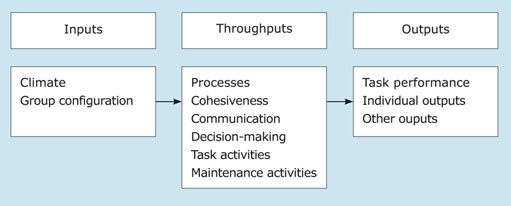2.2 The open systems approach to team working
Schermerhorn and colleagues suggest that teamwork can be considered as a three stage sequence. Teams are viewed as systems which take in resources such as time, people, skills, problems (inputs) and through transformational processes (throughputs) such as decision-making and different behaviours and activities, transform them into outputs, such as work, solutions and satisfactions (Ingram et al., 1997). This is illustrated in Figure 2.

Inputs are factors which are controlled and influenced by management. They include ‘climate’, the atmosphere under which the team works, and ‘group configuration’, how the team is put together, who is selected to work in it and why. Management will also influence how a team should work by making sure at the outset that the team strategy is in line with the vision and strategic direction of the organisation and that it uses the organisation’s preferred work practices; for example, face-to-face or virtual working.
Throughputs refer to the activities and tasks that help to transform inputs into outputs. They may have the greatest influence on effective team work as they include team processes such as developing and maintaining cohesiveness, and communication. They also involve task activities which get the work done and maintenance activities which support the development and smooth functioning of the team.
Outputs are those (successful) outcomes which satisfy organisational or personal goals or other predetermined criteria. The success of outputs may be assessed by a number of stakeholders, including the organisation itself and team members, and by a range of other stakeholders. Team outputs include the performance of team tasks and individual outputs (such as professional development).
How can this framework be applied in a way which highlights how to manage or lead a team and its task? Imagine you have been asked to put together a team to produce the company’s internal newsletter. What inputs, throughputs and outputs would you need? What questions would you need to ask yourself about different aspects of the process? We now consider what you might need to think about for the newsletter example. Some of the questions could be adapted and applied to other situations as well.
